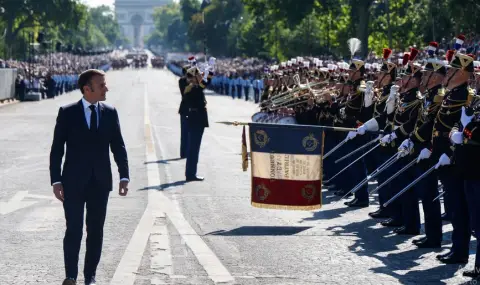The military parade on the occasion of the National Day of France, celebrated on July 14, was held in an unusual format in the center of Paris, and the host was French President Emmanuel Macron. In 2024, in connection with the preparations for the Olympics, the parade was moved to Avenue Foch, adjacent to the Champs-Élysées, named after Marshal of France Ferdinand Foch, who commanded the troops of the Republic and its allies in the First World War.
The parade was held under heightened security measures. Unlike previous years, when spectators could watch the parade from almost anywhere on the Champs-Élysées, this year all entrances to Avenue Foch were blocked by police and only spectators with tickets to the event were allowed onto the avenue itself.< /p>
On Macron's arrival at Avenue Foch, he was greeted by the Chief of the General Staff of the French Armed Forces, Army General Thierry Burkart, and the Military Governor of Paris, General Christophe Abad. The orchestra then performed for all present the French national anthem – “The Marseillaise”. After that, the head of state went to the podium, which this year was installed on the square "Charles de Gaulle" adjacent to the alley. Together with him on the podium were the first lady of France Brigitte Macron, the prime minister Gabriel Atal, members of the government and the president of the Senate (the upper house of the parliament) Gerard Larchet.

Macron arrived at the parade in the new presidential armored car Renault Rafale. As noted by the BFMTV channel, Renault, after several years of absence, “returned to the presidential garage”. with the new model. Last year, the French leader arrived at the parade in the DS7 ELYSEE SUV, produced for him by Groupe PSA, which owns the Peugeot and Citroen brands.
This year the parade took place according to a shortened program. Since the avenue Foch, where the review of the troops took place, is much narrower than the Champs-Élysées, tank and other motorized units had to be excluded from the program of the parade. The number of participants in the pedestrian part of the parade was reduced from 6,000 to 4,000 people.
At the same time, the air section did not undergo any changes: it was discovered by 22 helicopters, after which 43 aircraft of the French Air Force flew over the avenue. The French Air Patrol, a special aerobatic team consisting of nine Alpha Jet aircraft, traditionally painted the sky over Paris in the colors of the republic's flag. "It is an unusual route that has become a real challenge for the crews. “We had to re-plan the whole program,”, the newspaper Le Journal du Dimanche (JDD) quoted divisional aviation general Stefan Groen as saying.

The parade was dedicated to the 80th anniversary of the Allied landings in Normandy and the liberation of France (1944), which are being celebrated this year. Units from 14 countries that participated in the amphibious operation, as well as from 17 African countries, took part in it.
The final part of the parade was dedicated to the Olympic Games in Paris 2024, whose opening ceremony will take place on July 26. Colonel Thibaut Vallet, gold medalist in the equestrian team event at the 2016 Rio de Janeiro Olympics, carried the Olympic flame on horseback down Avenue Foch.
On July 14, 1789, the insurgent Parisians stormed the Bastille and freed the prisoners. This event marked the beginning of the Great French Revolution of 1789-1794. On its first anniversary in 1790, a celebration of national reconciliation was held in Paris.
July 14 officially became a national holiday of France in 1880. At the same time, the first military parade took place in Paris at the Longchamp racecourse. Since then, it has been held annually, except for the period 1940-1944, when France was occupied by Nazi Germany. In 1919, to commemorate the victory in the First World War, it was decided to move the parade to the Champs-Élysées.

